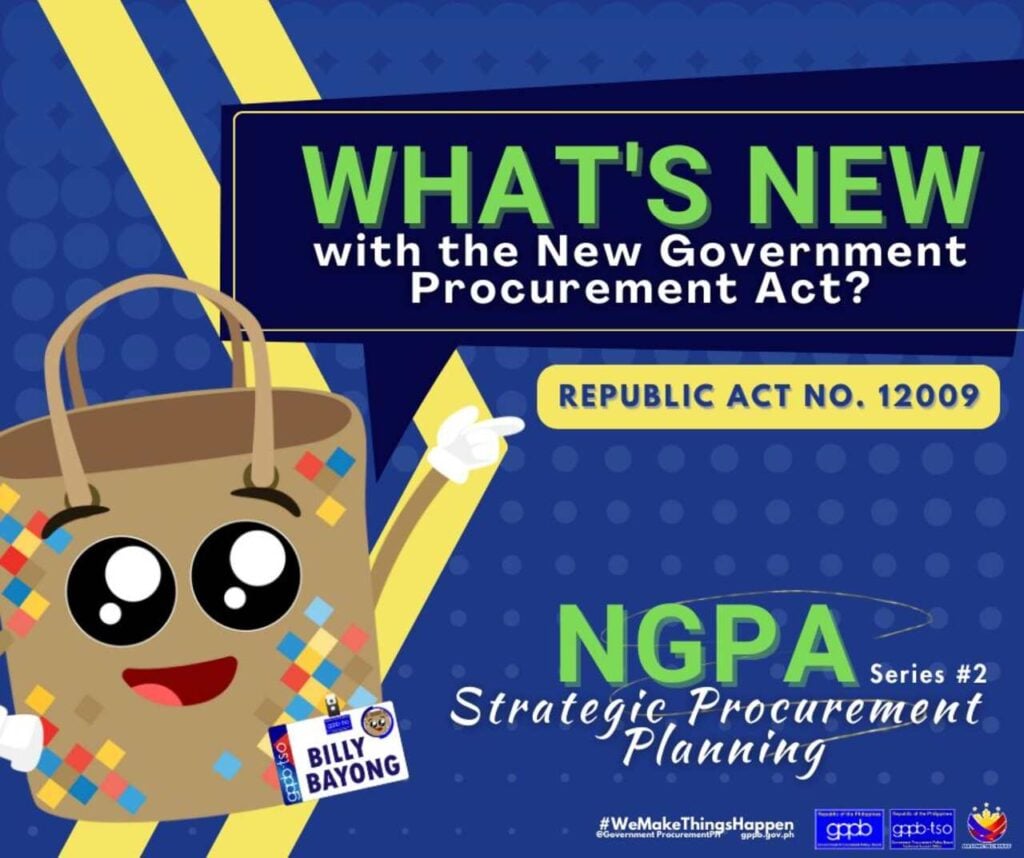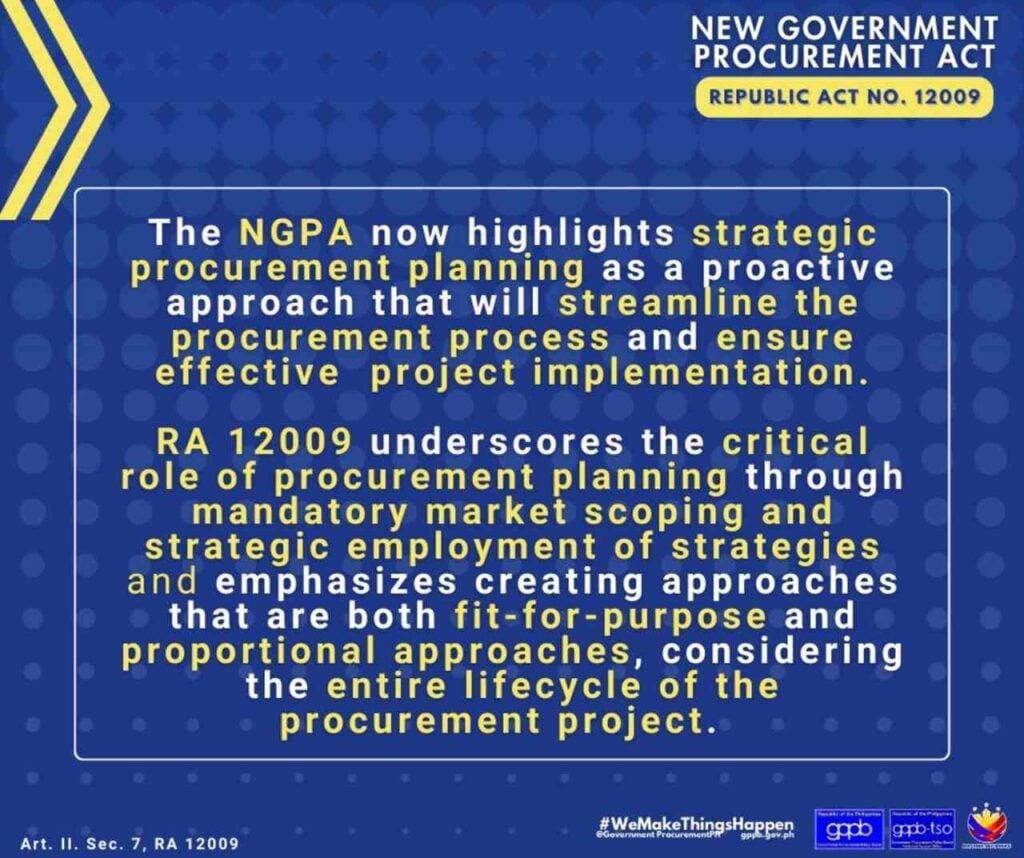The Republic Act No. 12009, or the New Government Procurement Act, is the latest Philippine legislation that revises Republic Act No. 9184, the Government Procurement Reform Act. It sets updated standards and procedures regulating how government agencies buy goods, build infrastructure (including transport), and hire consulting services—covering all levels of government (national agencies, state universities and colleges (SUCs), government-owned and controlled corporations (GOCCs), government financial institutions (GFIs), and local government units (LGUs), with foreign or local funding.
This law is designed to align procurement processes with modern governance ideals — focusing on transparency, competitiveness, efficiency, proportionality, accountability, public monitoring, professionalization, sustainability, and delivering value for public funds. It also sustains compliance with international treaties or agreements that the Philippine government is party to.

Purpose
The Act aims to standardize and modernize procurement practices by anchoring them on the following values: transparency, competitiveness, efficiency, proportionality, accountability, public monitoring, sustainability, professionalism, and value for money. It expands on RA 9184 to reflect current government procurement by:
- Making information more accessible to the public through open contracting practices.
- Providing equal opportunities for eligible and qualified suppliers, contractors, consultants, and service providers.
- Streamlining processes with organized, uniform, and technology-driven systems.
- Ensuring that contract requirements are reasonable and proportional to actual needs.
- Holding all officials and personnel involved accountable for their actions.
- Allowing public monitoring to promote prudent use of government resources.
- Incorporating sustainability and lifecycle considerations into procurement decisions.
- Professionalizing procurement through qualifications, competency frameworks, and ethics codes.
Scope and Coverage
RA 12009 covers the procurement of:
- Goods: Items, supplies, materials, and general support services, excluding consulting services and infrastructure projects.
- Infrastructure Projects: Construction, improvement, rehabilitation, demolition, repair, or maintenance of public structures, transport systems, utilities, and other related projects.
- Consulting Services: Technical or professional expertise beyond the capacity of the procuring agency, such as feasibility studies, design, supervision, and management services.
It applies regardless of the funding source — whether local or foreign — and respects international treaties or agreements where applicable.
What the Law Means
The law comes with the following benefits to its stakeholders:
- Government agencies benefit from more systematic and transparent procurement processes, better planning, and risk mitigation.
- Suppliers and contractors gain clearer access to bid opportunities, document requirements, and procurement mechanisms.
- Citizens and oversight bodies have greater visibility into procurement, enhancing accountability and public trust.
How RA 12009 Works

To help you better understand how this law works, this section summarizes all the key points of the law:
1. Strategic Procurement Planning
Before any procurement starts, agencies must conduct thorough planning, including:
- Market scoping to understand pricing, industry practices, and supply options.
- Assessing environmental and social impact.
- Considering lifecycle costs and sustainability.
- Preparing the Annual Procurement Plan (APP) with details like project name, description, procurement method, evaluation criteria, schedule, funding source, and approved budget.
2. Detailed Engineering for Infrastructure Projects
For infrastructure projects (except design-and-build schemes), detailed engineering, surveys, design approvals, and right-of-way acquisition must be completed before bidding.
3. Multi-Year Contracting
Agencies planning multi-year projects must secure prior authorization:
- NGAs and SUCs require a multi-year contracting authority (MYCA) from the DBM or their Boards.
- GOCCs, GFIs, and SUCs need board approval, while LGUs must get Sanggunian authorization.
- The total project cost under the MYCA determines the ABC.
4. Specifications and Standards
Product or service specifications should focus on functionality, performance, or recognized standards. Use of brand names is allowed only for compatibility, interoperability, warranty, or technical justification, and must be documented.
5. Early Procurement Activities
Agencies can start procurement processes before the next year’s budget is approved, provided they have an approved Indicative APP. Contracts can only be awarded once funding is finalized.
6. Lifecycle Assessment (LCA) and Lifecycle Cost Analysis (LCCA)
Procurement decisions must consider the total cost and usefulness of goods and projects over their entire life cycle.
Subcontracting Rules
For locally-funded and Official Development Assistance projects:
- Subcontracting must have prior approval from the Head of the Procuring Entity (HoPE).
- Subcontractors must meet eligibility requirements.
- General contractors must disclose subcontractors during bidding.
- General contractors remain responsible for subcontractor performance and compliance.
- Liability is shared for violations of safety or labor standards.
- Experience credit and access to financing may apply to subcontractors.
Framework Agreements and Pooled Procurement
The law allows:
- Framework Agreements: Long-term arrangements setting terms and conditions for multiple future contracts.
- Pooled Procurement: Joint purchasing among agencies to save costs and increase supply stability.
Warehousing and Inventory Management
Agencies may establish warehousing systems and adopt cloud-based inventory to track and manage procured goods. Coordination with the Department of Information and Communications Technology (DICT) is required to address security risks, ensure proper data security, audits, and accountability.
Procurement by Electronic Means
RA 12009 modernizes procurement through the Philippine Government Electronic Procurement System (PhilGEPS) — the single official online portal for all government procurement activities.
PhilGEPS features include:
- Electronic bulletin board.
- Supplier and contractor registry.
- Electronic catalog and marketplace.
- Virtual store.
- Reverse auction.
- Small value procurement tools.
- Electronic payment and bidding.
All agencies must register with PhilGEPS and integrate their systems for seamless data sharing.
Interconnectivity Between Government Databases
The Government Procurement Policy Board (GPPB) is authorized to link PhilGEPS with databases such as:
- DTI business registrations
- CIAP and PCAB contractor licensing
- LGU permits and licenses
- BIR tax data
- SEC and CDA enterprise and beneficial ownership information
- Insurance Commission surety listings
- Procuring Entity procurement statuses
- Other relevant agencies
This facilitates verification, transparency, and compliance, while safeguarding sensitive information.
Procurement Data Analytics
The GPPB’s Technical Support Office will use PhilGEPS data to:
- Aid strategic procurement planning
- Inform policy development
- Detect fraud or anti-competitive patterns
- Promote public awareness and participation
An annual procurement report will be published online to support transparency.
System Maintenance and Continuity
PhilGEPS must undergo periodic maintenance, upgrades, and backups. A business continuity plan is required, including backup sites to prevent service disruptions.
Requirements for Inclusion in the Annual Procurement Plan (APP)
Procurement projects must list:
- Name of the project/procurement.
- Project management office or end-user unit.
- General project description.
- Chosen procurement method (and outsourcing details if any).
- Criteria for bid evaluation.
- Time schedule.
- Source of funds.
- Approved Budget for the Contract.
Modes of Procurement
RA 12009 also outlines the different ways government agencies (Procuring Entities) can acquire goods, infrastructure projects, and consulting services, following a fit-for-purpose approach. These modes have specific conditions and must align with the law’s implementing rules and regulations (IRR). The Government Procurement Policy Board (GPPB) can update processes to adapt to modern technology.
- Competitive Bidding: Open to all eligible bidders, following steps like publication, pre-bid conference, eligibility screening, bid submission/opening, evaluation, post-qualification, and awarding.
- Limited Source Bidding: Invitation to pre-selected suppliers with proven expertise, used for specialized goods/services, major plant components, or security-related projects.
- Competitive Dialogue: Two-stage process where bidders propose solutions for complex, innovative, or undefined projects before submitting final technical and financial proposals.
- Unsolicited Offer with Bid Matching: Accepts innovative proposals from private parties, with the chance for others to submit competing bids.
- Direct Contracting: Directly buying from a single supplier when goods are proprietary, critical components are required, or only one exclusive dealer exists.
- Direct Acquisition: Direct purchase of goods/services worth ≤ ₱200,000 (adjustable), not available in PS-DBM.
- Repeat Order: Reordering goods from a previous winning bidder within 6 months, up to 25% of the original quantity.
- Small Value Procurement: Requesting at least three price quotes for projects ≤ ₱2 million (adjustable).
- Negotiated Procurement: Allowed in special cases like failed biddings, emergencies, contract take-overs, agency-to-agency deals, unique scientific or artistic works, hiring highly technical consultants, defense agreements, NGO/community participation, UN agency procurement, or direct retail purchases of fuel and online subscriptions.
- Direct Sales: Buying the same goods a supplier already provided to another agency under similar or better terms.
- Direct Procurement for Science, Technology & Innovation: Buying goods/services for R&D directly from capable suppliers or qualified startups.
Other Key Provisions
- Video Recording: Procurement-related meetings for large-value projects must be recorded and livestreamed for transparency.
- Prohibition on Contract Splitting: No breaking contracts into smaller parts to avoid bidding rules.
- Procurement of Common-Use Supplies and Equipment (CSE): Must be sourced from PS-DBM unless unavailable, with options for bulk purchasing and consignment.
What Sections Affect the Public
In particular, the public must take note of the sections that talk about:
- Transparency & Public Monitoring: Agencies must share procurement details openly, from planning to awarding contracts, letting citizens check each step.
- Sustainability & Lifecycle Approach: Projects must consider full lifecycle cost and environmental impact—so public infrastructure (like roads or rail) is built responsibly.
- Data & Analytics Disclosure: GPPB analyzes procurement data for patterns and posts findings publicly, helping watchdogs and civil society track compliance.
How This Affects the Transportation Sector
The transportation industry — covering roads, bridges, railways, airports, seaports, and related facilities — is directly impacted by RA 12009. The law’s emphasis on detailed engineering, sustainability, and lifecycle cost analysis means transport infrastructure projects will have stricter planning and quality standards. Contractors and suppliers in the sector must adapt to new documentation, eligibility, and e-procurement requirements to participate in government bids.
Video: New Government Procurement Act (RA 12009) Explained
The New Government Procurement Act (RA 12009) updates the country’s procurement framework to match current economic, technological, and governance realities. By promoting open access to procurement information, standardizing processes, and integrating sustainability, it aims to make government purchasing more efficient, fair, and responsible — with benefits for taxpayers, suppliers, and the public at large.
For more information, watch this video below:
For inquiries or other concerns, you may also visit the PhilGEPS official website and the Government Procurement Policy Board (GPPB) site.